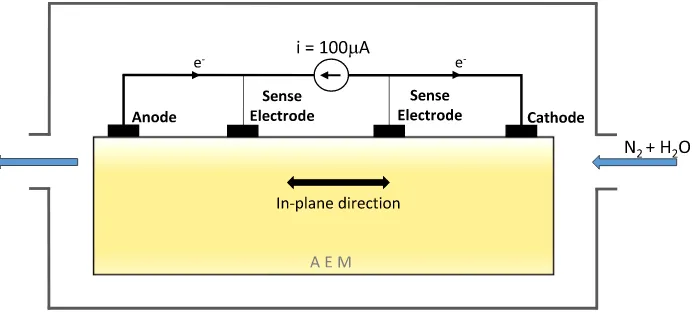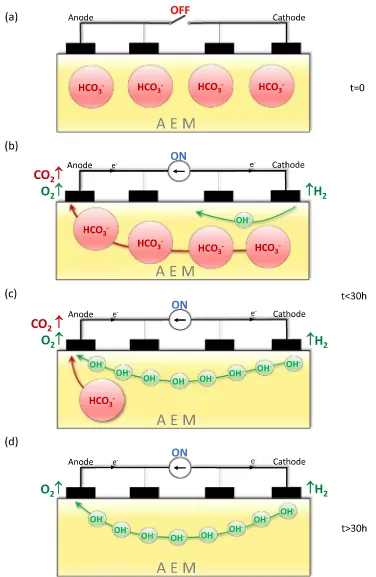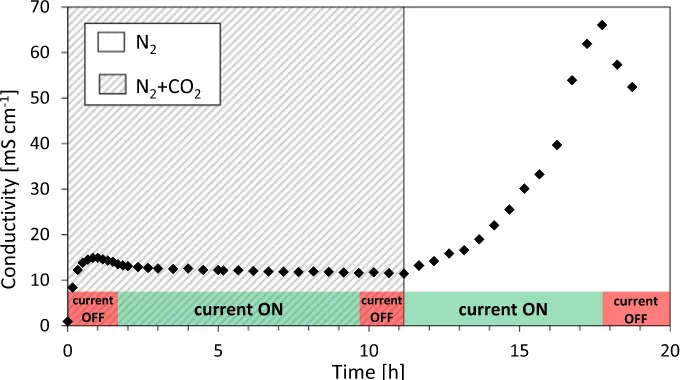Contents lists available atScienceDirect
Electrochemistry Communications
journal homepage:www.elsevier.com/locate/elecom
A practical method for measuring the true hydroxide conductivity of anion
exchange membranes
Noga Ziv, Dario R. Dekel
⁎The Wolfson Department of Chemical Engineering and the Nancy & Stephan Grand Technion Energy Program (GTEP), Technion–Israel Institute of Technology, Haifa
3200003, Israel
Hydroxide ions in anion exchange membranes (AEMs) are quickly exchanged for larger and less mobile anions (CO₃2−and HCO₃−) when the membrane is exposed to ambient air. Therefore, reported conductivity values of AEMs in hydroxide form are difficult to reproduce, and existing conductivity measurement techniques are not always reliable. Up to now, comparison of reported data for the hydroxide conductivity of different membranes has not been possible because tests have been performed not just with different anions, but also under different conditions and using different methods. In this work we present a practical and reproducible ex situ method for measuring the true value of the hydroxide conductivity of AEMs.
1. Introduction
Anion exchange membrane fuel cells (AEMFCs) have attracted a lot of attention in recent years due to their potential as highly effective, clean, low-cost sources of energy [1]. In an AEMFC, hydroxide anions (OH−) are the dominant anions transported through the anion ex-change membrane (AEM) from the cathode to the anode side of the cell [2].
The value of OH−conductivity is therefore critical in distinguishing between different membranes and in determining those most suitable for use in a fuel cell. However, the true OH− conductivity value is difficult to measure due to the fast reaction of OH− with CO₂ (ca. 400 ppm in ambient air), which replaces OH− with larger and less mobile anions–bicarbonate (HCO₃−) and carbonate (CO₃2−) (see
re-actions (1) and (2)) [3,4].
+ ⇄ −
OH– CO₂ HCO₃ (1)
+ −⇄ −+
OH– HCO₃ CO₃2 H₂O (2)
This carbonation process has significant effects on the AEM and the AEMFCs [5,6], which are not yet fully understood [7]. The reactions take place immediately upon exposing the membrane to ambient air and advance very quickly; it was found that during exposure to ambient air OH−was fully replaced within 1 to 6 h [8–11], and a decrease of 60–70% in conductivity was measured in only 40–60 min [12–14]. Some early works have disregarded this problem and measured OH− conductivity without CO₂removal, and therefore the obtained results
might reflect the conductivity of a mixed anion form of AEM instead of the pure OH−form [15,16].
To avoid these problems and measure the conductivity of an AEM in its pure OH−form, many works have used gas-purged water during the exchange process [13] or during measurement [8,17–21]. However, this method might produce carbonated AEMs since exposure of the membrane to ambient air for even a few minutes is sufficient to ex-change some of the OH−with (bi)carbonate, and there might be some dissolved CO₂in the water. Also, measuring the conductivity in water does not reflect the conditions in an operating fuel cell.
Another method that aims to overcome these challenges is the use of a glovebox containing an inert gas with ultra-low CO₂levels, in which the ion-exchange process of the membrane and measurement take place [22–24]. Among the disadvantages of this method are the complexity of performing AEM conductivity measurements, inconsistency in gas composition (mainly CO₂level) from one glovebox to another, and the problematic use of a large amount of degassed water inside the glo-vebox. In summary, the conditions which are currently used to measure the OH−conductivity of AEMs are usually hard to reproduce and not stable, making it impossible to compare reported data.
This work provides a new, ex situ, practical method for measuring true OH− conductivity. The method does not require the use of a complex glovebox, nor expensive fuel cell tests, neither does it involve chemical steps to convert the membrane into its hydroxide form.
https://doi.org/10.1016/j.elecom.2018.01.021
Received 19 January 2018; Received in revised form 30 January 2018; Accepted 31 January 2018 ⁎Corresponding author.
E-mail address:dario@technion.ac.il(D.R. Dekel).
Available online 02 February 2018
2. Experimental
2.1. Anion exchange membranes
We used PBI-based membranes in their carbonate form (HMT-PMBI 89.3% dm (degree of methylation), supplied by Holdcroft's group, Simon Fraser University, Canada). The preparation and characteriza-tion of the PBI-based AEMs have been reported elsewhere [25]. The AEM has a reported thickness of ca. 50 μm and an ion exchange ca-pacity (IEC) of 2.5 meq g−1. The hydroxide conductivity at room tem-perature (while immersed in liquid water) was reported to be 23 mS cm−1[13,25].
2.2. Hydroxide conductivity measurement method
The membrane samples in their carbonate form were mounted in a membrane test system (MTS 740, Scribner Associates Inc.). The samples were exposed to a continuous 500 sccm min−1gasflow containing ni-trogen (99.999% N2) or nitrogen with an ambient concentration of CO₂ (99.999% N2with 400 ppm CO₂), under constant 90% relative humidity at 40 °C. A constant direct current of 100μA (SP-300 potentiostat, Bio-Logic) was applied to the membrane (seeFig. 1).
Every 10 to 30 min, the ionic resistance of the membrane was measured using a standard 4-probe technique [26], and the in-plane anion conductivity was then calculated using the equation:
=
σ L
R W d· · (3)
where L is the distance between the two inner sensing electrodes (4.25 mm),Ris the membrane's resistance (measured by voltage scan-ning between ± 100 mV),Wis the sample width (ca. 10 mm) anddis the membrane's thickness (measured under wet conditions).
3. Results and discussion
Fig. 2shows the in-plane conductivity values measured in the AEM over a period of time. In the first stage, the membrane is left under experimental conditions without applying any current in order to reach an equilibrium. During this stage the conductivity changes slightly before reaching a relative stable value of ca. 15 mS cm−1. The slight changes in anion conductivity in thisfirst stage are believed to be a result of water exchange between the gas environment and the mem-brane, and the increase in the measurement cell's temperature from room temperature to 40 °C.
As can be seen inFig. 2, when a current of 100μA is applied through the membrane, its conductivity starts to increase at an apparently ex-ponential rate. This significant increase in measured anion conductivity is explained by the electrochemical reactions taking place at the elec-trodes. At the positive electrode (cathode), OH−is produced according to:
+ −→ −+
4H₂O 4e 4OH 2H₂ (4)
Fig. 1.Schematic illustration of the experimental setting.
The amount of water supplied with the humidified ambient gas is about ten orders of magnitude higher than the amount consumed in reaction (4), so water does not limit the electrochemical reaction. As a result of the current, the anions initially present in the membrane (HCO₃−/CO₃2−) move towards the negative electrode (anode), where CO₂is released via the following reactions [7]:
⇄ +
−
HCO₃ CO₂ OH– (5)
→ + +
− −
4OH 2H₂O O₂ 4e (6)
As a result of these reactions, the relative amount of OH−in the membrane continuously increases at the expense of the HCO₃−/CO₃2− concentration, thus increasing the measured anion conductivity values (seeFig. 2). Similar behavior was observed by Kimura et al. [27], but the authors did not continue their tests over a long period, and no stabilization in the conductivity readings was reached in that case. In our tests, we continued the measurements for approximately 30 h, until
all the carbonate anions were replaced by OH−. At this asymptotic value the measured conductivity reaches its maximum value, around 103 mS cm−1. We call this value the“true hydroxide conductivity”of the AEM, as it was obtained when all the carbonate anions had been replaced by the hydroxide, and therefore the membrane was in its pure OH−form.
The process described above is represented schematically inFig. 3. Before any current is applied,Fig. 3(a), the membrane contains large HCO₃− and CO₃2− anions (for simplicity only HCO₃− anions are shown). Once the current is switched on,Fig. 3(b), OH−
begins to form at the cathode and HCO₃−/CO₃2−anions begin to move towards the anode, while gases are generated at the electrodes according to reac-tions (4), (5) and (6). After ca. 2 h,Fig. 3(c), OH−is transported to the anode, the concentration of HCO₃−/CO₃2−decreases due to the release of CO₂ and the conductivity significantly increases. Finally, after ca. 30 h of applying 100μA, Fig. 3(d), all the HCO₃−/CO₃2−have been removed from the membrane, OH−anions continue to be transported through the membrane and its conductivity is stable, and at its max-imum value–its true hydroxide conductivity.
In order to confirm that the AEM is entirely in its OH−
form after the point when the membrane reaches its maximum conductivity, we switched the gas inlet from nitrogen to nitrogen containing 400 ppm of CO₂(gray area inFig. 2) at ca. 36 h.Fig. 2shows that after CO₂ is introduced into the atmosphere, the conductivity immediately de-creases to a value close to its initial value. This is a result of the im-mediate reaction of OH−with CO₂to create HCO₃−/CO₃2−through
reactions (1) and (2), which causes a decrease in conductivity, even though the current is still applied. This decrease confirms that OH−is produced during application of current, that it is responsible for the increase in conductivity, and that once the membrane is back in contact with CO₂, the conductivity corresponding to the fully carbonated form is obtained.
To further confirm that the increase in conductivity results from the electrochemical removal of CO₂ from the membrane, a similar (al-though inverse) procedure was carried out using N2with 400 ppm CO₂ as the ambient gas, and the results are presented inFig. 4. In the pre-sence of CO₂, OH−anions produced inreaction (4)will immediately react to create HCO₃−and CO₃2−viareactions (1) and (2). The con-ductivity therefore remains constant at the initial value corresponding to the AEM in its HCO₃−/CO₃2−form. When theflowing gas is switched to pure nitrogen (without CO₂), the conductivity increases since OH−is not neutralized by CO₂and its concentration in the membrane can in-crease. This clearly proves that OH−is formed, and HCO₃−and CO₃2− are removed from the membrane while the current is applied, causing the increase in conductivity values.
It should be remarked that the true hydroxide conductivity value found in this work using the proposed method, 103 mS cm−1, is twice as high as the conductivity value of the same membrane measured after the common practice of aqueous KOH soaking followed by water washing in a CO2-free chamber (~50 mS cm−1). Also, using our pro-posed method, we succeed in showing an increase in conductivity of ca. 6 times for thefinal OH−form compared to ~15 mS cm−1for the in-itial air-equilibrated AEM containing HCO₃−and CO₃2−. This ratio is significantly higher than the ratio obtained in the literature using conventional glovebox-based methods [7]. This strengthens the con-clusion that our method can indeed be used to measure the true hy-droxide conductivity value of an AEM.
4. Conclusions
We present a novel, practical, ex-situ method for measuring the true value of the hydroxide conductivity of AEMs. The method is based on forcing the release of the larger (bi)carbonate anions as CO₂ gas by applying an external electric current through the membrane. The cur-rent forces electrochemical reactions in the AEM at the electrodes so that OH−is formed at one electrode, and HCO₃−/CO₃2−are purged as CO₂at the other electrode, until all the anions in the membrane are exchanged in situ to OH−
. This method offers excellent reproducibility compared with the methods currently used to measure OH− con-ductivity. Finally, the method involves relatively simple instrumenta-tion and configuration, and conditions closer to those found in an op-erating fuel cell.
By adopting this new anion conductivity measurement method the research community willfinally be able to compare hydroxide con-ductivity between different AEMs in a reliable and reproducible way. We strongly recommend the adoption of this method for measuring the hydroxide conductivity of AEMs.
Declarations of interest
No conflict of interest.
Acknowledgements
This work was partially funded by the Grand Technion Energy Program (GTEP); by the European Union's Horizon 2020 - Research and Innovation Framework Programme [grant number 721065]; by the Ministry of Science, Technology and Space of Israel through the M.era-NET Transnational Call 2015, NEXTGAME project [grant number 3-12948]; by the 2nd Israel National Research Center for Electrochemical
Propulsion (INREP2-ISF); by the Ministry of National Infrastructure, Energy and Water Resources of Israel [grant no. 3-13671 and as part of the scholarship program for undergraduate and graduate students in thefield of energy]. This work was also partially funded by the Israel Science Foundation (ISF), grant no. 1481/17.
References
[1] J.R. Varcoe, P. Atanassov, D.R. Dekel, A.M. Herring, M.A. Hickner, P.A. Kohl, A.R. Kucernak, W.E. Mustain, K. Nijmeijer, K. Scott, T. Xu, L. Zhuang, Anion-ex-change membranes in electrochemical energy systems, Energy Environ. Sci. 7 (2014) 3135–3191,http://dx.doi.org/10.1039/C4EE01303D.
[2] S. Gottesfeld, D.R. Dekel, M. Page, C. Bae, Y. Yan, P. Zelenay, Y.S. Kim, Anion exchange membrane fuel cells: current status and remaining challenges, J. Power Sources 375 (2018) 170–184,http://dx.doi.org/10.1016/j.jpowsour.2017.08.010. [3] X. Wang, W. Conway, R. Burns, N. McCann, M. Maeder, Comprehensive study of the hydration and dehydration reactions of carbon dioxide in aqueous solution, J. Phys. Chem. A 114 (2010) 1734–1740,http://dx.doi.org/10.1021/jp909019u. [4] T.D. Myles, K.N. Grew, A.A. Peracchio, W.K.S. Chiu, Transient ion exchange of
anion exchange membranes exposed to carbon dioxide, J. Power Sources 296 (2015) 225–236,http://dx.doi.org/10.1016/j.jpowsour.2015.07.044. [5] U. Krewer, C. Weinzierl, N. Ziv, D.R. Dekel, Impact of carbonation processes in
anion exchange membrane fuel cells, Electrochim. Acta 263 (2018) 433–446, http://dx.doi.org/10.1016/j.electacta.2017.12.093.
[6] D.R. Dekel, Review of cell performance in anion exchange membrane fuel cells, J. Power Sources 375 (2018) 158–169,http://dx.doi.org/10.1016/j.jpowsour.2017. 07.117.
[7] N. Ziv, W.E. Mustain, D.R. Dekel, Review of ambient CO2effect on anion exchange
membranes fuel cells, ChemSusChem (2018),http://dx.doi.org/10.1002/cssc. 201702330.
[8] H. Yanagi, K. Fukuta, Anion exchange membrane and ionomer for alkaline mem-brane fuel cells (AMFCs), ECS Trans. 16 (2008) 257–262,http://dx.doi.org/10. 1149/1.2981860.
[9] S. Suzuki, H. Muroyama, T. Matsui, K. Eguchi, Influence of CO2dissolution into
anion exchange membrane on fuel cell performance, Electrochim. Acta 88 (2013) 552–558,http://dx.doi.org/10.1016/j.electacta.2012.10.105.
[10] J. Kizewski, N. Mudri, R. Zeng, S. Poynton, R.C.T. Slade, J.R. Varcoe, Alkaline electrolytes and reference electrodes for alkaline polymer electrolyte membrane fuel cells, ECS Trans. 33 (2010) 27–35,http://dx.doi.org/10.1149/1.3484498. [11] M.G. Marino, J.P. Melchior, A. Wohlfarth, K.D. Kreuer, Hydroxide, halide and water
transport in a model anion exchange membrane, J. Membr. Sci. 464 (2014) 61–71, http://dx.doi.org/10.1016/j.memsci.2014.04.003.
[12] J. Yan, M.A. Hickner, Anion exchange membranes by bromination of benzylmethyl-containing poly(sulfone)s, Macromolecules 43 (2010) 2349–2356,http://dx.doi. org/10.1021/ma902430y.
[13] A.G. Wright, J. Fan, B. Britton, T. Weissbach, H.-F. Lee, E.A. Kitching, T.J. Peckham, S. Holdcroft, Hexamethyl-p-terphenyl poly(benzimidazolium): a universal hydro-xide-conducting polymer for energy conversion devices, Energy Environ. Sci. 9 (2016) 2130–2142,http://dx.doi.org/10.1039/C6EE00656F.
[14] A. Amel, N. Gavish, L. Zhu, D.R. Dekel, M.A. Hickner, Y. Ein-Eli, Bicarbonate and chloride anion transport in anion exchange membranes, J. Membr. Sci. 514 (2016) 125–134,http://dx.doi.org/10.1016/j.memsci.2016.04.027.
[15] Q. Li, L. Liu, Q. Miao, B. Jin, R. Bai, A novel poly(2,6-dimethyl-1,4-phenylene oxide) with trifunctional ammonium moieties for alkaline anion exchange mem-branes, Chem. Commun. 50 (2014) 2791,http://dx.doi.org/10.1039/c3cc47897a. [16] N.J. Robertson, H.A. Kostalik, T.J. Clark, P.F. Mutolo, H.D. Abruña, G.W. Coates,
Tunable high performance cross-linked alkaline anion exchange membranes for fuel cell applications, J. Am. Chem. Soc. 132 (2010) 3400–3404,http://dx.doi.org/10. 1021/ja908638d.
[17] R. Janarthanan, J.L. Horan, B.R. Caire, Z.C. Ziegler, Y. Yang, X. Zuo,
M.W. Liberatore, M.R. Hibbs, A.M. Herring, Understanding anion transport in an aminated trimethyl polyphenylene with high anionic conductivity, J. Polym. Sci. B Polym. Phys. 51 (2013) 1743–1750,http://dx.doi.org/10.1002/polb.23164. [18] J. Xue, L. Liu, J. Liao, Y. Shen, N. Li, UV-crosslinking of polystyrene anion exchange
membranes by azidated macromolecular crosslinker for alkaline fuel cells, J. Membr. Sci. 535 (2017) 322–330,http://dx.doi.org/10.1016/j.memsci.2017.04. 049.
[19] N. Li, Y. Leng, M.A. Hickner, C.-Y. Wang, Highly stable, anion conductive, comb-shaped copolymers for alkaline fuel cells, J. Am. Chem. Soc. 135 (2013) 10124–10133,http://dx.doi.org/10.1021/ja403671u.
[20] M. Unlu, J. Zhou, P.A. Kohl, Anion exchange membrane fuel cells: experimental comparison of hydroxide and carbonate conductive ions, Electrochem. Solid-State Lett. 12 (2009) B27,http://dx.doi.org/10.1149/1.3058999.
[21] J.A. Vega, C. Chartier, W.E. Mustain, Effect of hydroxide and carbonate alkaline media on anion exchange membranes, J. Power Sources 195 (2010) 7176–7180, http://dx.doi.org/10.1016/j.jpowsour.2010.05.030.
[22] J. Wang, S. Gu, R. Xiong, B. Zhang, B. Xu, Y. Yan, Structure-property relationships in hydroxide-exchange membranes with cation strings and high ion-exchange ca-pacity, ChemSusChem 8 (2015) 4229–4234,http://dx.doi.org/10.1002/cssc. 201501035.
[23] T.P. Pandey, A.M. Maes, H.N. Sarode, B.D. Peters, S. Lavina, K. Vezzù, Y. Yang, S.D. Poynton, J.R. Varcoe, S. Seifert, M.W. Liberatore, V. Di Noto, A.M. Herring, Interplay between water uptake, ion interactions, and conductivity in an e-beam grafted poly(ethylene-co-tetrafluoroethylene) anion exchange membrane, Phys. Chem. Chem. Phys. 17 (2015) 4367–4378,http://dx.doi.org/10.1039/ C4CP05755D.
[24] J. Ponce-González, D.K. Whelligan, L. Wang, R. Bance-Soualhi, Y. Wang, Y. Peng, H. Peng, D.C. Apperley, H.N. Sarode, T.P. Pandey, A.G. Divekar, S. Seifert, A.M. Herring, L. Zhuang, J.R. Varcoe, High performance aliphatic-heterocyclic benzyl-quaternary ammonium radiation-grafted anion-exchange membranes, Energy Environ. Sci. 9 (2016) 3724–3735,http://dx.doi.org/10.1039/ C6EE01958G.
[25] A.G. Wright, S. Holdcroft, Hydroxide-stable ionenes, ACS Macro Lett. 3 (2014) 444–447,http://dx.doi.org/10.1021/mz500168d.
[26] K.R. Cooper, Characterizing through-plane and in-plane ionic conductivity of polymer electrolyte membranes, ECS Trans. 41 (2011) 1371–1380,http://dx.doi. org/10.1149/1.3635668.
[27] T. Kimura, Y. Yamazaki, Effects of CO2concentration and electric current on the


